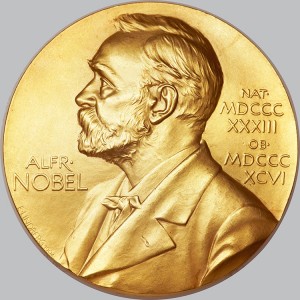Nobel Prize in Chemistry
October 5, 2017
Yesterday, October 4, the Royal Swedish Academy of Sciences in Stockholm, Sweden, awarded the 2017 Nobel Prize in chemistry to three molecular biologists: Jacques Dubochet, Joachim Frank, and Richard Henderson. The three made key contributions to the development of cryo-electron microscopy (cryo-EM) for producing high-resolution images of biomolecules (molecules from living things).
An electron microscope uses a beam of electrons to magnify a specimen. It can produce detailed images of smaller areas than can an optical microscope, which uses beams of light. The wavelength (distance between wave crests) of an electron beam is much shorter than that of a light beam. This allows an electron microscope to make very small structures visible.
After the first electron microscopes were built in the 1930’s, they became important tools in chemistry, medicine, physics, and other scientific areas. In the 1970’s and 1980’s, Joachim Frank developed an image-processing method that turned the electron microscope’s fuzzy, two-dimensional images into sharp, three-dimensional ones. This greatly improved researchers’ abilities to study the fine details of microscopic structures.
Scientists thought, however, that electron microscopes were useful only for imaging dead matter. The intensity of an electron beam destroyed biological material. Electron microscopes also require a vacuum (space with little matter) to work. Biomolecules collapse in a vacuum. In the 1980’s, Jacques Dubochet used cryotechnology (technology involving very low temperatures) to solve these problems. He surrounded a biomolecule in water and cooled the water so rapidly that it solidified as a glasslike structure around the specimen. This protected the specimen from the effects of the vacuum, with its natural shape and structure remaining intact. This also protected the specimen from the electron beam’s harmful radiation.
In 1990, Richard Henderson produced an image of a protein at atomic resolution (visible at the scale of an atom). This breakthrough came after decades of work carefully preparing specimens and adding details to the image. Henderson traveled around the world to find electron microscopes with the sharpest resolutions to enhance his protein model. Henderson’s image proved that cryo-EM could be used to produce images in fine detail.
The work of Dubochet, Frank, and Henderson paved the way for cryo-electron microscopy. Researchers can now freeze biomolecules in a natural stage or pose and portray them at a very high resolution. Frank was born in Siegen, Germany, in 1940. He earned his Ph.D. degree in 1970 from the University of Munich. Dubochet was born in Aigle, Switzerland, in 1943. He received his Ph.D. degree in 1973 from the Universities of Basel and Geneva. Henderson was born in Edinburgh, Scotland, in 1945. He earned his Ph.D. degree in 1969 from Cambridge University in the United Kingdom.



